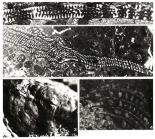Foraminifera taxon details
Perouvianella peruviana (Steinmann, 1930) †
1049413 (urn:lsid:marinespecies.org:taxname:1049413)
accepted
Species
Orbiculina peruviana Steinmann, 1930 † · unaccepted (Type species of Perouvianella)
marine, brackish, fresh, terrestrial
fossil only
(of Orbiculina peruviana Steinmann, 1930 †) Steinmann, G. (1930). Geologie von Perú. <em>Heidelberg : C. Winter.</em> 1-448.
page(s): p. 152 [details]
page(s): p. 152 [details]
Hayward, B.W.; Le Coze, F.; Vachard, D.; Gross, O. (2024). World Foraminifera Database. Perouvianella peruviana (Steinmann, 1930) †. Accessed at: https://www.marinespecies.org/Foraminifera/aphia.php?p=taxdetails&id=1049413 on 2024-05-16
Date
action
by
original description
(of Orbiculina peruviana Steinmann, 1930 †) Steinmann, G. (1930). Geologie von Perú. <em>Heidelberg : C. Winter.</em> 1-448.
page(s): p. 152 [details]
additional source Consorti, L.; Navarro-Ramirez, J. P.; Bodin, S.; Immenhauser, A. (2018). The architecture and associated fauna of Perouvianella peruviana, an endemic larger benthic foraminifera from the Cenomanian–Turonian transition interval of central Peru. <em>Facies.</em> 64(1)[electronic pre-publication2017]: 1-15., available online at https://doi.org/10.1007/s10347-017-0514-z [details] Available for editors [request]
[request]
page(s): p. 152 [details]
additional source Consorti, L.; Navarro-Ramirez, J. P.; Bodin, S.; Immenhauser, A. (2018). The architecture and associated fauna of Perouvianella peruviana, an endemic larger benthic foraminifera from the Cenomanian–Turonian transition interval of central Peru. <em>Facies.</em> 64(1)[electronic pre-publication2017]: 1-15., available online at https://doi.org/10.1007/s10347-017-0514-z [details] Available for editors
From editor or global species database
Diagnosis Porcelaneous planispiral-involute shells with a lens shape in the early stages of growth becoming flabelliform to fan-shaped in the late stages. Apertures are small, elongated and multiple, distributed in at least three equatorial rows. The lateral skeleton is composed of radial partitions (septula), which constrain small, rectangular open spaces (pseudoalcoves). Septula extend from the proximal side (basal layer) growing fused with the lateral pillars. Septula occupy almost half of the chamber height leaving a relatively wide passage in the preseptal lateral position. The central part of the chamber is occupied by at least two rows of alternating pillars, more rows of pillars may be added during ontogeny. Both septulae and pillars arise from the basal layer, their thickened base forming socculi. Socculi are relatively thick on the proximal side of the chambers where they are represented by a crest which interconnects pillars at their base (socculi crests). Two types of intercameral foramina connect the successive chambers; the central ones which alternate with pillars, and the lateral ones which alternate with septula. Crests interconnecting pillars constrain conical cavities with circular slightly irregular sections. Each conical cavity hosts an intercameral foramina. The skeletal elements such as septula and pillars are aligned from one chamber to the next. Stolon axes are radially arranged. The megalosphere possess a narrow flexostyle passage. The nepionic growth of microspheric forms is not known. Dimorphism is distinct. [details]
